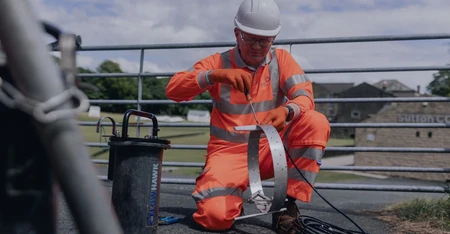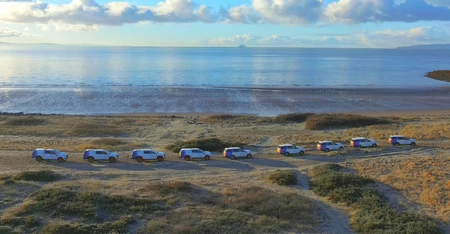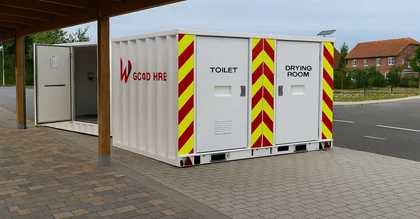Reduce the impact of noise pollution on local communities, people and the environment with noise monitoring services.
We understand the importance of addressing noise-related concerns for our clients in various industries. With our extensive experience, we specialise in providing comprehensive a noise survey for the manufacturing industry, property developers, railway systems, local authorities, and individuals facing noise nuisances.
When we talk about environmental noise, we refer to any unwanted sound in and around your home or neighborhood. This includes industrial noise, noise from transportation sources, and even noise originating from residential properties. It's worth noting that noise pollution is a significant environmental issue, often leading to numerous complaints received by Environmental Health Officers.
According to the Health and Safety Executive (HSE), a staggering 170,000 people in the UK are estimated to suffer from noise-induced hearing loss, tinnitus (persistent ringing in the ears), temporary or permanent threshold shift, or other acoustic trauma conditions caused by excessive noise exposure in the workplace.
At SOCOTEC, we prioritise our clients' well-being and aim to provide tailored solutions to their noise-related challenges. Our expertise and dedication ensure that we deliver accurate and reliable results, enabling you to address and mitigate the impact of excessive noise effectively.
What is environmental and occupational noise?
Environmental noise is defined as unwanted or harmful outdoor sound on a given premises and the surrounding locality. It is created by human activity and incorporates elements such as industrial noise (welding, hammering, drilling, grinding etc), noise from transport and noise from domestic premises, such as recreational activities.
Further examples of environmental noise include:
- Industrial and commercial noise
- Railway and traffic noise
- Construction noise
- Quarry noise
- Industrial process noise
- Hospitality noise.
Occupational noise relates to high levels of noise in the workplace. Noise induced hearing loss caused by exposure to noise at work continues to be a significant occupational disease. With years of experience, SOCOTEC can provide occupational noise exposure monitoring in various industries including automotive, food, manufacturing and railway.
Data collected from noise level measurement and monitoring enables organisations to understand trends and actions that can be taken to reduce noise pollution, ensuring safer and acceptable noise levels in the workplace and the wider community.

Talk to our experts

Environmental Noise
Surveys and Monitoring

Suitable and accurate environmental noise measurement must be conducted using noise monitoring equipment. A variety of noise monitors can be used, with the technique/device selected depending upon the environmental noise to be measured or assessed. This can range from handheld noise monitors, which allow users to make a quick judgement about the levels of noise, to outdoor noise measurement kits, which allow monitoring of noise for ongoing periods/longer durations.
For an environmental noise survey, noise level measurements of a plant, process, activity or any other identified source is taken to identify areas and environments where noise levels may be of concern or issue and to identify the prevailing noise climate in a given receptor area/location. Noise surveys are usually undertaken using a sound level/noise meter and cover:
- Machines and equipment which generate elevated levels of noise
- Noise control options to reduce the impact of noise on receptors
- Variability in noise levels during different operating conditions
- Impact on noise level from modifications or changes in operations.
- Noise modelling is another example of a monitoring that can be used when the need to make comparisons between new and existing noise climates is required, such as when making modifications to an existing site. Lastly, noise prediction from potential construction sites and road traffic is essential in helping to identify the degree of noise nuisance.
Suitable and accurate environmental noise measurement must be conducted using noise monitoring equipment. A variety of noise monitors can be used, with the technique/device selected depending upon the environmental noise to be measured or assessed. This can range from handheld noise monitors, which allow users to make a quick judgement about the levels of noise, to outdoor noise measurement kits, which allow monitoring of noise for ongoing periods/longer durations.
For an environmental noise survey, noise level measurements of a plant, process, activity or any other identified source is taken to identify areas and environments where noise levels may be of concern or issue and to identify the prevailing noise climate in a given receptor area/location. Noise surveys are usually undertaken using a sound level/noise meter and cover:
- Machines and equipment which generate elevated levels of noise
- Noise control options to reduce the impact of noise on receptors
- Variability in noise levels during different operating conditions
- Impact on noise level from modifications or changes in operations.
- Noise modelling is another example of a monitoring that can be used when the need to make comparisons between new and existing noise climates is required, such as when making modifications to an existing site. Lastly, noise prediction from potential construction sites and road traffic is essential in helping to identify the degree of noise nuisance.
Typical Applications
- To assess noise nuisance in mixed industrial and residential areas in accordance with BS 4142 ‘Method for Rating Industrial Noise Affecting Mixed Residential & Industrial Areas’
- To determine noise levels generated by construction sites and to advise on control measures in accordance with BS 5228 ‘Noise Control on Construction & Open Sites’
- To measure environmental noise from an industrial site as a requirement of ISO 14001 Environmental Management System, or for determining compliance with planning consent
- For assisting land developers with planning applications, following guidance in Department of Environment Publication PPG 24 ‘Planning & Noise’.
Noise Modelling
When considering the noise aspects of a new development, or modifications to an existing site, it is usually necessary to predict the new noise climate for comparison with the current situation. Noise prediction from potential construction sites and road traffic are also essential to determine the degree of noise nuisance. SOCOTEC use the latest software to undertake complex calculations associated with environmental noise propagation.
An acoustic model of an area is generated on to a topographical map by entering items such as point sources of noise, buildings, ground and foliage regions, housing regions, industrial sites and surface contours. The software is then used to determine predicted noise levels at receiver points and generate a noise contour diagram. The advantages of modelling are:
- It is largely a desk-top exercise when noise data is already available
- It facilitates the calculation of the effects of many noise sources simultaneously
- The effects of moving / removing / adding / attenuating noise sources can be determined quickly and easily
- The calculations are based on international standards of computing sound propagation
- It produces easily understood contour diagrams.
What is the purpose of an occupational noise assessment?
To ensure that employees are protected from excessive noise in their place of work, an assessment of their exposure to noise must be made by a competent person to identify those at risk, determine exposure levels, implement noise reduction, and control measures where necessary.
A suitable and sufficient risk assessment must be undertaken for those liable to be exposed to a noise level at or above a lower exposure action value.
The results of the assessment can be compared to the exposure action values and exposure limit value, as defined by the regulations. If any employee is likely to be exposed to noise at or above an upper exposure action value, the employer must then eliminate the noise at source or reduce exposure to as low a level as is reasonably practicable by establishing and implementing a programme of organisational and technical measures.
How are occupational noise assessments conducted?
SOCOTEC’s qualified occupational hygienists use the latest high-specification instrumentation and offer services throughout the UK, which includes:
- Dosemeters worn by a subject (particularly if the person is highly mobile), which can continuously monitor noise exposure for later transfer to a PC and data interpretation.
- Sound level meters conforming to Type 1 Specification of BS EN 60651: 1994, used for fixed-point measurements, measurements close to the operator, and for octave band frequency analysis and a hearing protection suitability assessment.
- Calibrators for checking instrument accuracy.
How can SOCOTEC support with noise monitoring?
SOCOTEC has a wealth of experience in dealing with environmental noise to the manufacturing industry, property developers, the railway, local authorities and complainants experiencing a noise nuisance. By monitoring and assessing environmental noise, SOCOTEC can issue fully-comprehensive reports of all measurements taken, interpreted against current legislation and guidance. Where necessary, advice and recommendations can be given including immediate actions to control noise nuisance, and possible control measures to reduce noise complaints. SOCOTEC UK can provide environmental noise assessments/guidance and noise predictions with the use of approved noise modelling software and calculation methods for planning applications.
SOCOTEC issue fully-comprehensive reports of all measurements taken, interpreted against current legislation and guidance. Where necessary, advice and recommendations are given including:
- Advising you on the requirements of the Control of Noise at Work Regulations
- Immediate actions to reduce noise exposure
- Immediate actions to control noise exposure
- Selection of suitable hearing protection, based on octave band frequency analysis
- Noise zoning by mapping of the noise measurements, should these levels be consistent.
Data Visualisation
Blue Trust (online monitoring software) is SOCOTEC’s secure online data visualisation tool. All data from the monitoring equipment on site will be uploaded to Blue trust, which will be configured to display data at regular intervals for the selected parameters on a unique plan view. The monitoring system is capable of sending threshold breach alerts (SMS/emails) when defined trigger limits are breached. Individual user accounts will also be provided to client contacts to view and download monitoring data.
Want to find out more about SOCOTEC's Environmental Monitoring and Consultancy services?
You might also be interested in:

SOCOTEC UK & Ireland partners with Mesothelioma UK

SOCOTEC UK and Ireland Celebrates Double Nomination at Environmental Monitoring Awards

Summer Environmental Conference 2025

SOCOTEC UK Partners with Applied Genomics to Introduce Environmental DNA Analysis Suite

SOCOTEC ACQUIRES ASPECT LAND & HYDROGRAPHIC SURVEYS LTD, STRENGTHENING ITS SPECIALIST SURVEYING SERVICES AND ENVIRONMENTAL PORTFOLIO

SOCOTEC UK Proudly Supports Portgordon Community Trust with Vital Legionella Risk Assessment

Rail Excellence: Securing the East Midlands Railway Contract








